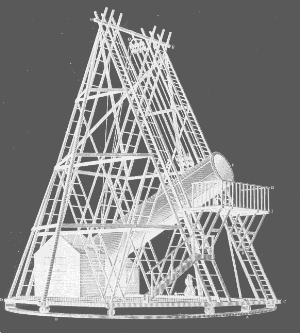Seeing the Universe
1780 - Herschel's large reflectors
In 1781 William Herschel discovered the planet Uranus. He also discoverd
moons around Saturn and Uranus, realised that spectrum of star light extended
beyond the visble into the infrared, mapped thousands of nebulae, and deduced
the structure of the Milky Way. In his quest for better views of the universe,
he built a series of reflecting telescopes. The image shows the largest,
with a 48 inch mirror, constructed in 1786. It prooved difficult to use.
The observer, standing on the platform, peering into the body of the instrument,
steered it onto targets by calling out instructions to a team of workmen. They
pushed the structure around its track and hauled on ropes, running through a pulley
system, to raise or lower the tube. Herschel returned to doing most of his work on
an earlier, more manageable, 24 inch reflector.
![]() The Herschel Museum
The Herschel Museum

Herschel's 48 inch reflecting telescope (Herschel Museum)